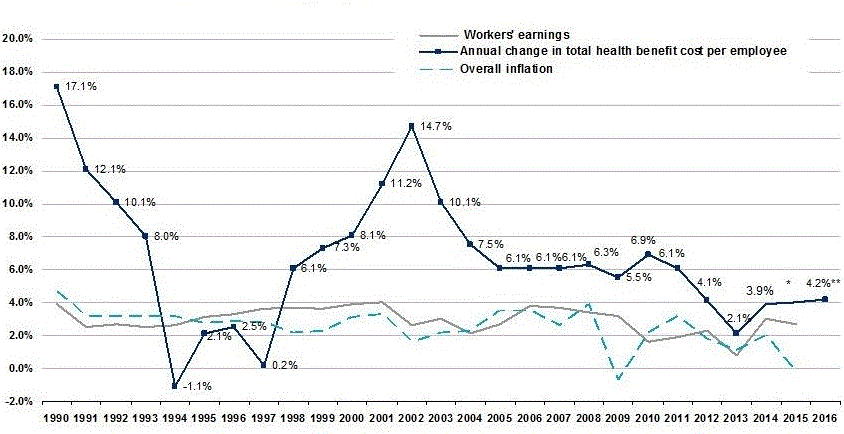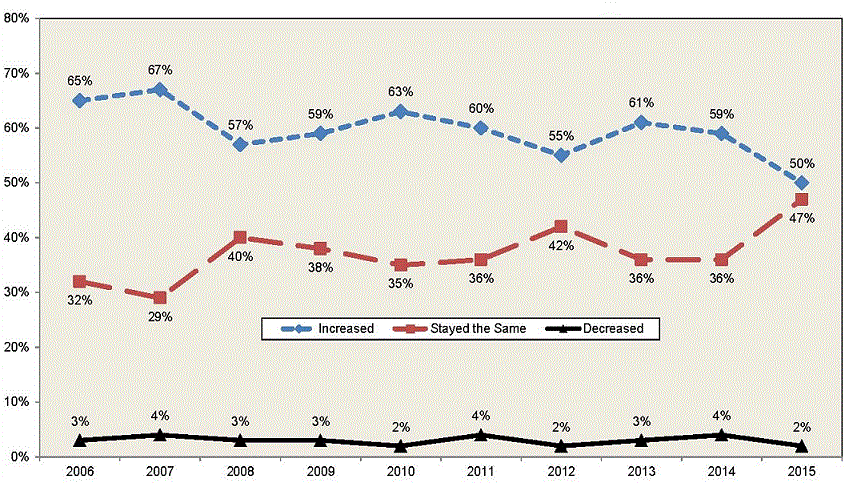Compared to the steep spikes in health plan premiums seen in years past, rate
increases for 2016 will remain relatively modest for most medical plan options,
although still outpacing overall inflation as represented by the consumer price
index (CPI).
But costs will increase substantially for prescription drug coverage, hitting
double-digit rates, according to forecasts based on recent health cost trend
surveys.
Price inflation for hospital services and brand-name medications were the
leading drivers of plan cost increases, Segal found. In particular, cost
trend rates for prescription drug coverage are expected to be significantly
higher in 2016:
•
11.3 percent for carve-out coverage for active employees and retirees under age
65, and 10.9 percent for retirees age 65 and over. Both projections are roughly
3 percentage points greater than projections for 2015.
•
The projected specialty drug/biotech drug cost trend rate is expected to remain
extremely high at 18.9 percent, but slightly lower than the projection for
2015.
•
Utilization rates (the number of medical treatments, prescriptions dispensed and
hospital admissions) are forecast to drop 1 to 2 percent and are a minor factor
in cost increases.
Offsetting Higher Deductibles
But overall, in light of more modest health plan cost increases,
cost-shifting to employees will be more restrained compared with past years that
saw large rate increases, Ed Kaplan, national health practice leader in HR
consultancy Segalfs New York City office, told SHRM Online.
gCorporate plans have made some cost-shifting decisions over the last couple
of years, but it was six to 10 years ago that the biggest shifts took place,h
said Kaplan. gIn the last couple of years, we havenft seen major wholesale
changes, such as replacing all of the [available employer-provided] plans with a
high-deductible plan, for example. Or if they went from a $300 deductible to a
$500 deductible in the past, typically they havenft moved it up to $700. If they
had a primary care physician co-pay of $20 and it went to $25, itfs tended to
stay there.h
Even as employers are adding high-deductible plan options to promote
cost-conscious spending decisions and hold down premiums, gthe deductible may be
increasing, but [employers are] offsetting that with contributions to health
savings accounts [HSAs], for example,h said Kaplan. gIf theyfve added an HSA,
theyfre deciding if theyfre going to increase their contribution.h
For the most part, HSA contributions are holding steady, he noted. gSince the
claims experience has been very good for the most part on the high deductible
plansh—which is evidence that they are helping to hold down medically
unnecessary spending—gwefre seeing less of a cost increase in terms of payroll
deduction for the workers who are currently in a high-deductible plan,h although
employers seem more apt to gtweak [upward] payroll deduction for traditional HMO
or traditional PPO plansh that have lower deductibles.
Kaplan said hefs optimistic that plan sponsors that engage in
cost-controlling strategies will continue to get high value from their medical
benefit programs, while controlling plan cost increases in the future (see gFive
Steps to Control Health Plan Costs,h below).
2016 Cost Increases Tempered by Plan
Changes
Early responses released in September 2015 from a major Mercer survey still
in the field show employers predicting that health benefit costs per employee
will rise by 4.2 percent on average in 2016 after they make planned changes,
such as raising deductibles or switching carriers. This is consistent with the
actual cost growth Mercer found in 2014 (3.9 percent) and the expected cost
growth for 2015.
More than 1,200 employers responded to Mercerfs National Survey of Employer-Sponsored Health
Plans.
|
Average Health Benefit Cost per
Employee Projected to Rise by Less than 5%
for the Fifth
Straight Year
 Source: Mercerfs National Survey of
Employer-Sponsored Health Plans. Source: Mercerfs National Survey of
Employer-Sponsored Health Plans.
|
gWhat is surprising–and encouraging–is the slowdown in the underlying cost
growth, the increase employers would expect if they made no changes to their
medical plans,h said Tracy Watts, senior partner in Mercerfs Washington, D.C.,
office and the consultancyfs national health reform leader. gEmployers said
costs would rise by an average of 6.4 percent in 2016 if they made no changes.
Thatfs down from 7.1 percent for 2015 and is the lowest rate of underlying cost
growth seen since Mercer began collecting this information in 2005,h she noted.
Despite the slower cost trend, more than half of the survey respondents (54
percent) planned to make some changes to their programs in 2016. gEmployers are
well-aware that the ACAfs [Affordable Care Actfs] excise tax on high-cost plans
is slated to go into effect in 2018, even as calls for reform or repeal are
mounting,h said Watts.
Mercer has estimated that, based on plan cost reported in 2014, about a third
of all employers (31 percent) were on track to reach the excise tax threshold.
Fewer Seeing Cost Increases; Hardships for
Those Who Are
While the above surveys polled insurers and employers, fewer workers, when
asked, indicated they experienced health care cost increases in 2015 compared
with previous years.
Results from the 2015 Health and Voluntary Workplace Benefits Survey by the
nonprofit Employee Benefit Research Institute (EBRI) and research firm Greenwald
& Associates show that one-half of workers report having experienced an
increase in health care costs in 2015—down from 59 percent in 2014 and a
historical low for the annual survey. The findings are published in the
September 2015 issue of EBRI Notes.
|
Percentage of Individuals Reporting
an Increase or Decrease
in Premiums or Cost-Sharing,
2006-2015
 Source: Employee Benefit Research
Institute and Greenwald & Associates. Source: Employee Benefit Research
Institute and Greenwald & Associates.
|
Nevertheless, the survey found that high health costs cause financial
difficulties for many workers, and that those experiencing cost increases
continue to report that they are changing the way they use the health care
system:
•
Nearly 7 in 10 (69 percent) said increased costs have led them to try to take
better care of themselves, and 52 percent indicated they choose generic drugs
more often.
•
One-half said they go to the doctor only for more serious conditions or symptoms
(49 percent) and 43 percent said that they delay going to the doctor.
•
23 percent said they have decreased their contributions to retirement plans.
Workers' ratings of their own health plans continue to be generally
favorable, the survey found. One-half of those with health insurance coverage
are extremely or very satisfied, while only 9 percent are not satisfied with
their current health plan.
Five Steps to
Control Health Plan Costs
Plan sponsors are continuing to look for ways to manage costs by taking
a closer look at their health plans. Segalfs 2016
Health Plan Cost Trend Survey report advises that successful cost
management typically involves taking one or more of these actions:
•
Perform data analytics and data mining. Use workforce
health data and metrics to evaluate the performance of health plans,
to make changes to lower costs by reducing plan waste and inefficiencies,
and to target disease-management programs.
•
Manage use of specialty drugs. Given the expected double-digit
cost increase for specialty pharmacy drugs, consider prescription
benefit design changes such as requiring prior authorization,
implementing step therapy, mandating use of a limited network of specialty
pharmacies and identifying preferred treatments within disease
categories.
•
Request competitive proposals. With the recent
merger activity among medical and pharmacy benefit networks, plan
sponsors that conduct market bids can upgrade contract terms and realize
significant savings.
•
Consider narrow or custom provider networks. Seeking out only the
best
quality, highest value hospital and physician groups may result in
lower unit costs and better long-term outcomes. The trade-off of less
choice for plan participants will need to be studied against the financial
returns these narrow networks can offer.
•
Adopt a cafeteria-style approach to health benefit coverage
options. Plan sponsors that have not moved to a cafeteria-style
menu of plan offerings with a fixed
defined contribution funding strategy may want to consider this
approach. |
2015 Employer Health Plan Numbers
To help put the 2016 rate forecasts in perspective, herefs a look at health
plan premiums as they stood in 2015 and related plan numbers.
Single and family premiums for employer-sponsored health insurance rose an
average of 4 percent in 2015, continuing a decade-long period of moderate
growth, according to the Kaiser Family Foundation/Health Research &
Educational Trust (KFF/HRET) 2015 Employer Health Benefits Survey released in September.
Since 2005, premiums have grown an average of 5 percent each year, compared to
11 percent annually between 1999 and 2005, the survey noted.
The average annual premium for single coverage was $6,251, of which workers
on average paid $1,071. The average family premium was $17,545, with workers on
average contributing $4,955.
The KFF/HRET survey also found that:
•
81 percent of covered workers were in plans with a general annual deductible, on
average, of $1,318 for single coverage in 2015.
•
Covered workers in smaller firms (three to 199 workers) faced an average
deductible of $1,836 this year—66 percent more than the $1,105 average
deductible facing covered workers at large firms (with at least 200
workers).
Since 2010, both the share of workers with deductibles and the size of those
deductibles have increased sharply. These two trends together result in a 67
percent increase in deductibles since 2010, much faster than the rise in single
premiums (24 percent) and about seven times the rise in workersf wages (10
percent) and general inflation (9 percent).
Stephen Miller, CEBS, is
an online editor/manager for SHRM.
 Source: Mercerfs National Survey of
Employer-Sponsored Health Plans.
Source: Mercerfs National Survey of
Employer-Sponsored Health Plans. Source: Employee Benefit Research
Institute and Greenwald & Associates.
Source: Employee Benefit Research
Institute and Greenwald & Associates.